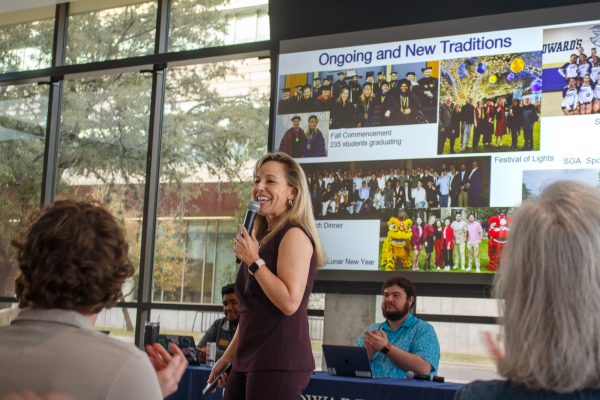9OZONE
If you’ve ever witnessed large, white weather balloons flying off the side of the Mary Moody Northen theatre, then you’ve seen Gary Morris’ Tropospheric Ozone Project in motion.
The project, funded by the Capital Area Council of Governments and the Texas Commission on Environmental Quality, launches 16 balloons over the course of two ozone seasons to measure tropospheric ozone levels.
According to Paul Walter, a professor of physics, ozone is a gas that occurs naturally in the atmosphere as the result of high-energy light splitting apart O2 molecules and creating free-floating oxygen molecules. Those molecules then rebond with O2 molecules to form O3, or ozone.
But ozone levels have increased drastically due to urban pollution; in the troposphere, the lowest portion of the earth’s atmosphere, ozone is produced as a result of VOC’s or Volatile Organic compounds, reacting with the sunlight.
This contributes to the thick layers of smog that are seen over the city during the early morning hours, but is not just a problem for urban areas. Walter said that wind blows the ozone over to rural areas and is problematic for residents.
“You don’t want to breathe this stuff in,” Walter said. “It’s harmful to your lungs, and in terms of agriculture, it does damage the plants. It’s a highly reactive molecule and so then there’s billions of dollars of crops that aren’t as productive as they could’ve been because the leaves are getting damaged by ozone.”
Part of the project entails sending up equipment to measure the levels of ozone present in the atmosphere (that’s where the balloons come in) and the other part is analyzing the data.
The ozonesonde, the device attached to the balloon which measures the ozone levels and air pressure, transmits radio signals back to a ground receiver and the research team is then able to read the information collected on the computer.
All the data is accessible from a data repository on campus. The data is supposed to help the city identify days when ozone levels are especially high and what is causing them.
Originally, the project began at Rice University in Houston where Morris was teaching at the time. Morris said he noticed that there were almost no Houston natives studying ozone, the city’s main pollutant, and thought it was ironic.
“When I arrived in August of 2000, there was a large scientific campaign underway to do measurements all over town to understand the ozone pollution problem there…all these scientists from all over were coming from all over to study it. And so I decided to learn about ozone pollution.”
After having hosted more than 750 flights throughout various cities in Texas, other parts of the United States and even Chile and Japan, Morris brought the project to St. Edward’s, where he and a team of students and faculty facilitate launches and track the city’s ozone levels.
Morris said that although pollution from the city contributes to high ozone levels in Austin, a lot of it can be accounted for by looking at ozone blown over from other cities.
Valeria Gonzalez, a senior mathematics major who is helping on the project said that the group even tracked ozone coming from a fire in Houston.
“It’s interesting to see where the ozone is coming from,” Gonzalez said.
Gonzalez helps Walter for part of a research hour credit. Her job is to help discern where the ozone came from by tracing the trajectory of air patterns. She said that she was glad to be part of the project because it is unique. Ozone levels generally aren’t studied closely in Austin.
“It’s something that hasn’t been looked at in Austin at all. I’m really happy that St. Edward’s provides these opportunities for research,” Gonzalez said. “The quality of the research is something that you wouldn’t expect at the undergraduate level. I am really impressed.”






